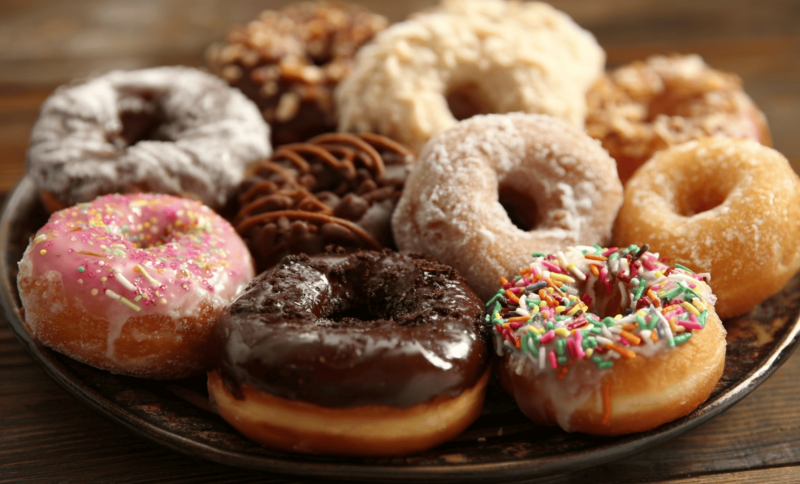Imagine walking past a bakery early in the morning. The warm smell of sugar, butter, and fresh coffee fills the air. On display are rows of shiny glazed donuts calling your name.
Your mouth waters, your hand almost reaches out… but then you pause and think: “How many calories are in a donut?”
If you’ve ever wondered this, you’re not alone. Donuts are one of America’s favorite snacks, but they’re also packed with sugar, fat, and oil.
Let’s analyze the average calories in a donut, the calories in an old-fashioned donut, and compare the calories in different varieties.
Why Calories in a Donut Matter
Calories aren’t the enemy, but they matter if you want to stay healthy. A calorie is simply energy, and your body needs it to breathe, move, and think.
The problem arises when you consume more calories than you expend. Extra calories get stored as fat, which can lead to weight gain over time.
That’s why knowing the calories in a donut is important. When you understand the numbers, you can enjoy your favorite treat without guilt.
It’s all about balance, planning ahead so a donut fits into your day without throwing off your goals.
The Average Calories in a Donut
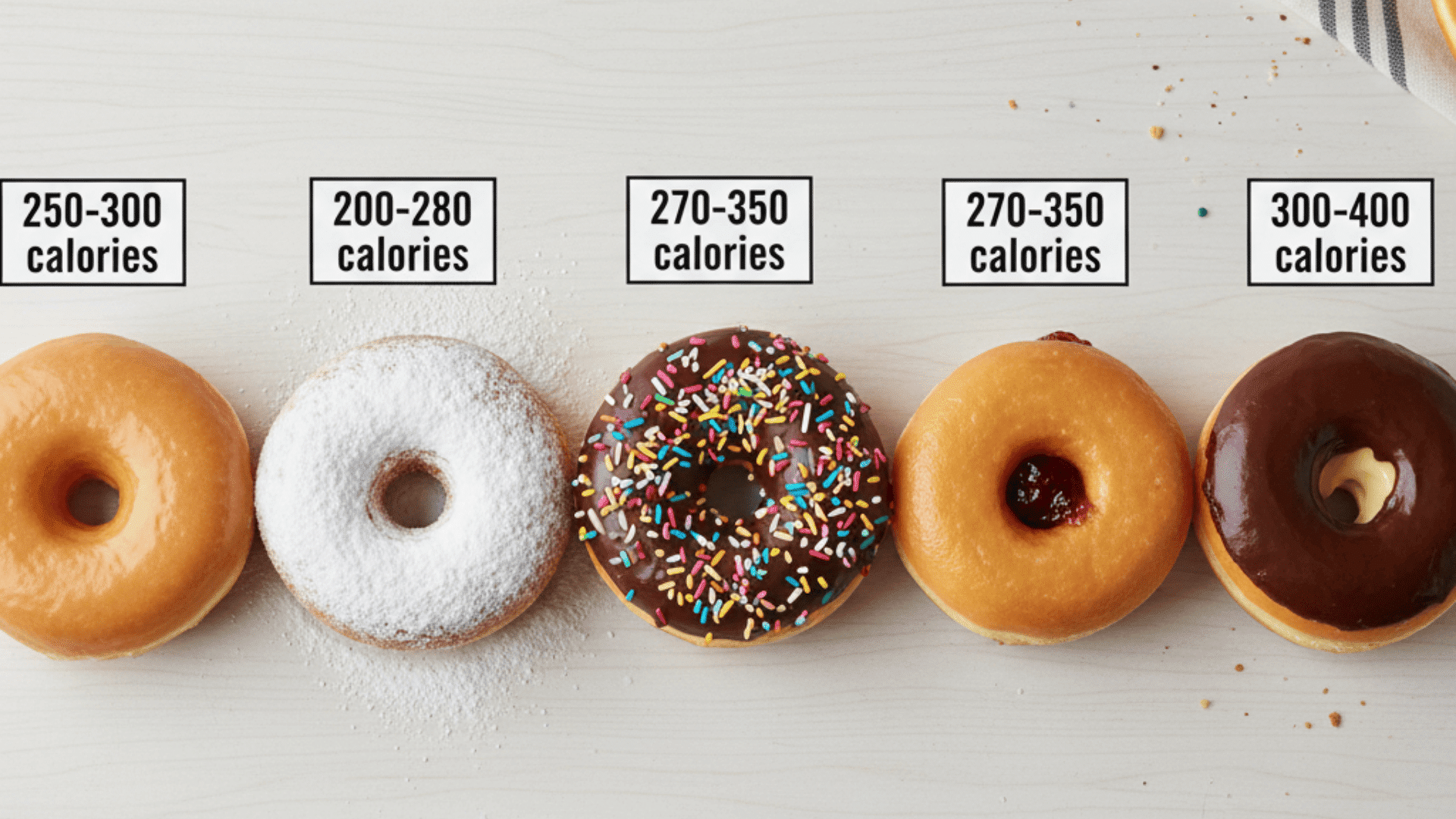
So, how many calories are in a donut on average? The truth is, it depends on the type, size, and toppings. Here’s a quick look at a standard-sized (50- 70g) donut:
- Plain glazed donut (medium size): around 250–300 calories
- Powdered sugar donut: about 200–280 calories
- Chocolate frosted donut: usually 270–350 calories
- Jelly-filled donut: around 270–350 calories
- Boston cream donut: 300–400 calories (because of the custard filling)
For reference, most adults require 1,800–2,400 calories per day, depending on their age, sex, and level of physical activity.
That means a single donut can account for 10–20% of your daily sugar and fat intake.
Calories in an Old Fashioned Donut
One popular style is the old-fashioned donut, known for its slightly crunchy outside and soft, cake-like inside. Many people love dipping it in coffee. But what about the calories?
- Old-fashioned donut (plain): about 320–350 calories
- Old-fashioned donut with glaze: closer to 350–400 calories
This makes it a bit heavier than a simple glazed donut. Why? Old-fashioned donuts are denser, made with more butter and oil, and often fried for a longer period. If you enjoy one of these, it’s like eating the calorie equivalent of a small meal.
What Adds Calories to Donuts?
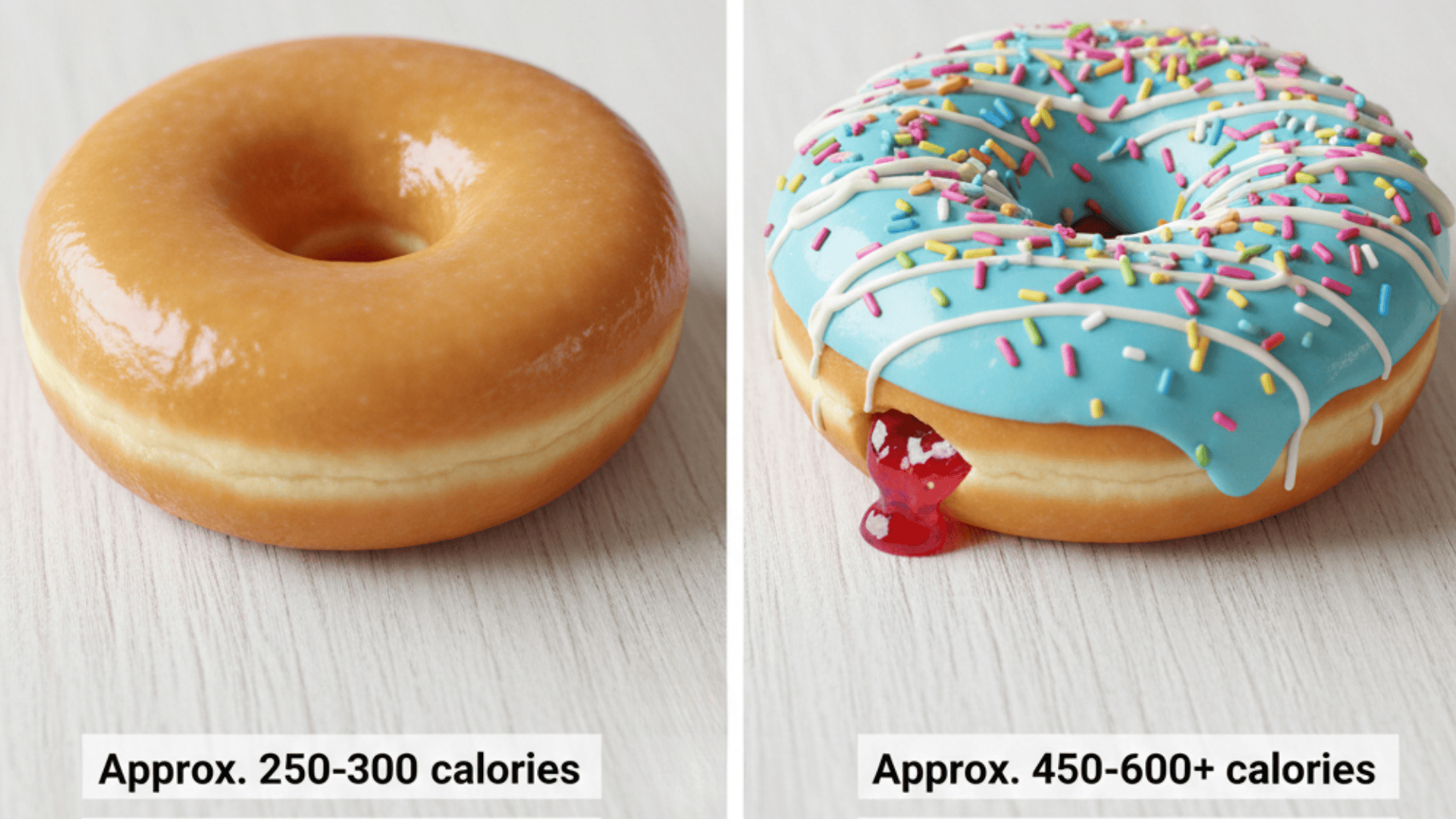
Not all donuts are created equal. The calorie difference mostly comes from three things:
- Size – Mini donuts are usually under 100 calories each, while giant bakery donuts can pack over 500 calories.
- Frying oil – Donuts are deep-fried, which means they soak up oil and add fat.
- Toppings and fillings – Frosting, sprinkles, jelly, cream, or caramel drizzle can double the sugar and calorie content.
In short, the more decorated your donut is, the higher the calorie count will be.
Nutrition Facts of Famous Donuts
If you love variety, you’ll enjoy this section. Here’s a look at the nutrition facts for popular donuts, simplified.
| Donut Type | Serving (g) |
Calories |
Fat (g) | Sat. Fat (g) | Chol (mg) | Sodium (mg) | Carbs (g) | Sugar (g) | Protein (g) |
|---|---|---|---|---|---|---|---|---|---|
| Glazed Donut | 52 | 260 | 14 | 6 | 25 | 210 | 31 | 12 | 4 |
| Old Fashioned Donut | 57 | 340 | 19 | 8 | 30 | 270 | 36 | 15 | 5 |
| Chocolate Frosted | 55 | 280 | 15 | 6 | 25 | 240 | 34 | 16 | 4 |
| Jelly-Filled Donut | 75 | 310 | 16 | 6 | 25 | 320 | 41 | 20 | 4 |
| Boston Cream Donut | 76 | 330 | 17 | 7 | 30 | 320 | 40 | 18 | 5 |
| Powdered Sugar Donut | 60 | 280 | 14 | 6 | 25 | 250 | 37 | 18 | 4 |
| Maple Bar | 85 | 420 | 20 | 9 | 35 | 350 | 55 | 27 | 6 |
| Apple Fritter | 100 | 450 | 22 | 9 | 40 | 370 | 58 | 29 | 6 |
| Cruller | 60 | 310 | 17 | 7 | 30 | 260 | 35 | 14 | 5 |
| Cinnamon Twist | 80 | 390 | 19 | 8 | 35 | 330 | 52 | 24 | 6 |
| Blueberry Cake Donut | 70 | 350 | 18 | 7 | 30 | 300 | 44 | 20 | 5 |
This donut nutrition breakdown reveals the significant variations in sugar, fat, and calories by type, enabling you to make more informed choices.( Sat. Fat: Saturated fat and chol: Cholesterol):
Comparing Donuts to Other Breakfast Foods
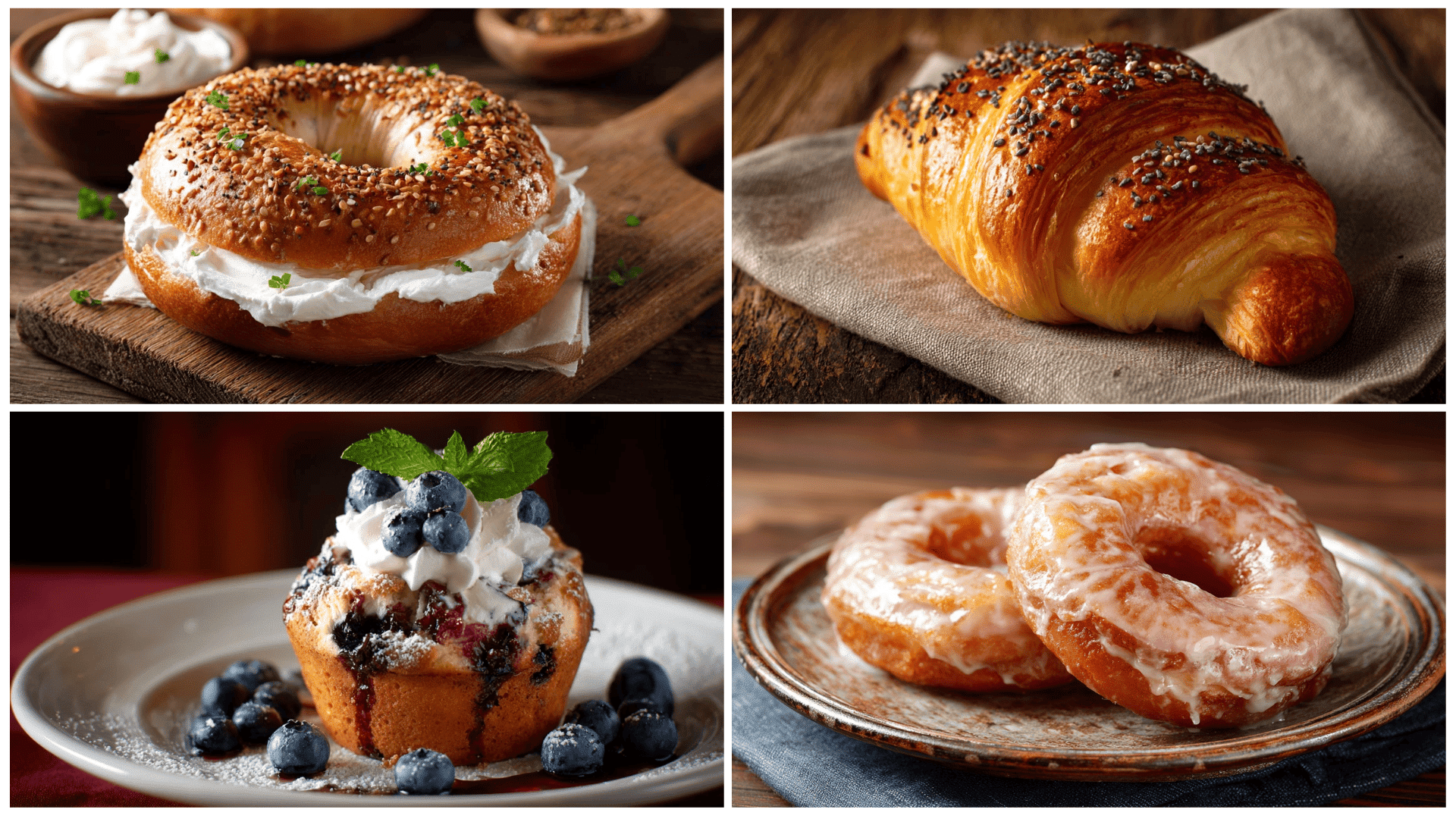
You might be thinking, “Okay, donuts are high in calories, but how do they compare to other breakfast foods?” Let’s see:
- Bagel with cream cheese: 350–450 calories
- Muffin (blueberry or chocolate chip): 400–500 calories
- Croissant: 250–300 calories
- Donut (average): 250–350 calories
Surprisingly, donuts aren’t always the heaviest choice. But the difference is that donuts are usually higher in sugar and lower in protein.
That’s why they give you a quick energy rush but often leave you feeling hungry again soon after.
How to Burn Off the Calories from a Donut
So, you’ve just enjoyed a donut, now what? To balance things out, exercise is an effective way to burn off those extra calories.
A standard donut is approximately 280 calories, and depending on your level of activity, the burn time can vary significantly.
Here’s a breakdown of how long common activities take to burn off one donut:
| Activity | Calories Burned per Minute | Time to Burn ~280 Calories |
|---|---|---|
| Walking (3.5 mph) | ~5 cal/min | ~55–60 minutes |
| Jogging (5 mph) | ~10 cal/min | ~28–30 minutes |
| Cycling (moderate) | ~8–9 cal/min | ~32–35 minutes |
| Weight Training | ~6 cal/min | ~45–47 minutes |
| Swimming (leisure) | ~8–9 cal/min | ~32–35 minutes |
| Dancing | ~5–6 cal/min | ~50–55 minutes |
As you can see, a 30-minute jog is roughly enough to cancel out a standard donut, while walking takes about an hour.
Activities like cycling or swimming burn calories more efficiently, making them a faster way to balance your sweet treat.
Note: These numbers are averages based on a person weighing ~155 lbs (70 kg). Your actual calorie burn will vary depending on body weight, intensity, and fitness level.
Homemade Donuts vs. Store-Bought
Another question people often ask is whether homemade donuts are healthier than store-bought ones. The answer? It depends on how you make them.
- Baked donuts: Made in an oven, not fried, and can be as low as 180–220 calories each.
- Air-fried donuts: These use significantly less oil, saving 50–100 calories compared to their deep-fried counterparts.
- Store-bought donuts are typically fried in oil and topped with sugar, averaging 250–400 calories.
So yes, homemade or baked donuts can be a lighter option if you want to indulge more often.
Healthier Ways to Enjoy Donuts
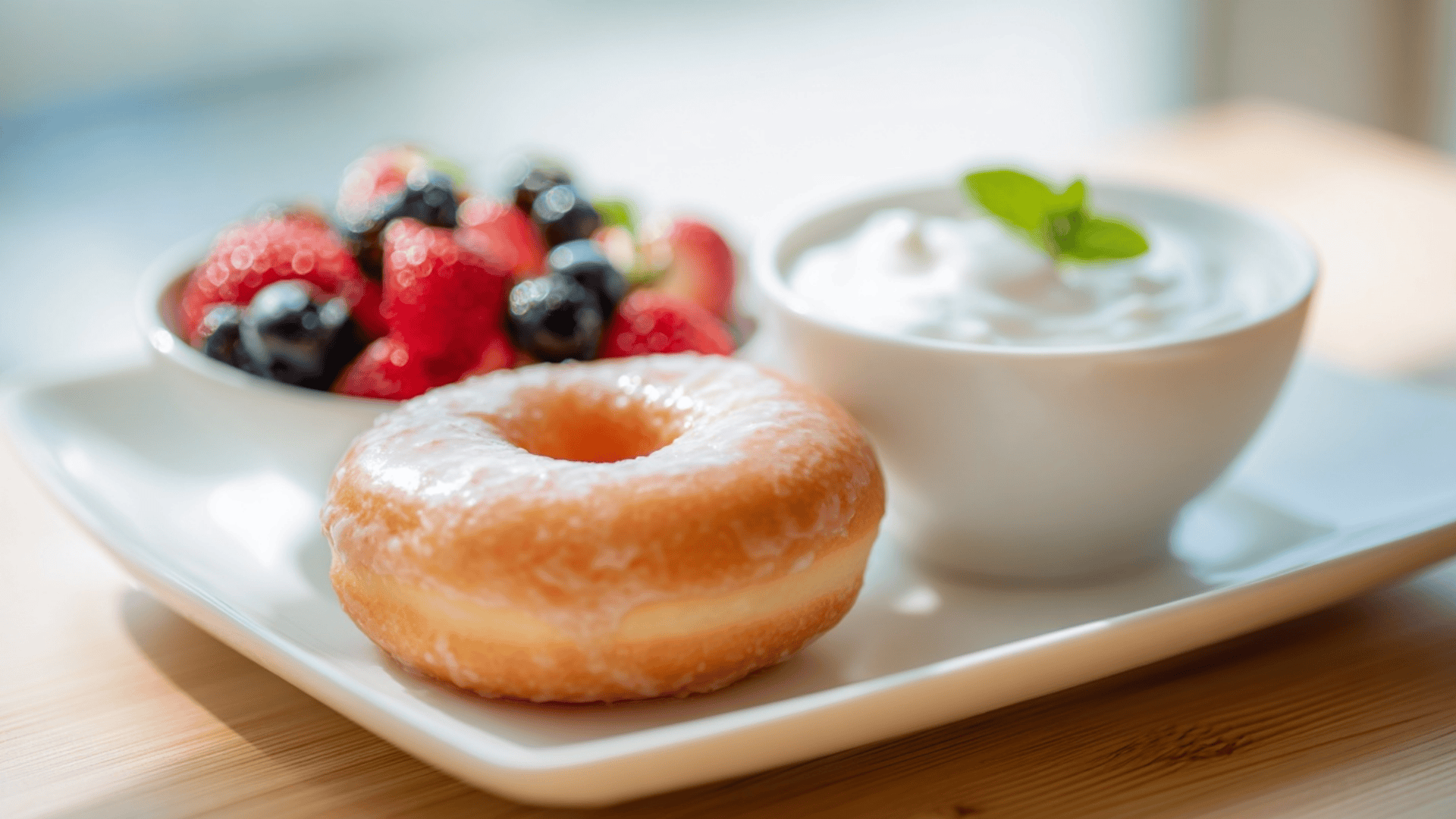
You don’t need to give up donuts completely because the key is moderation and making smarter choices.
Sticking to plain or glazed donuts helps since they usually have fewer calories than frosted or filled varieties.
Choosing smaller portions, such as mini donuts or donut holes, allows you to enjoy the same sweet taste without going overboard.
Pairing your donut with protein-rich foods, such as eggs, yogurt, or a protein shake, can also help keep you fuller for longer.
Finally, being mindful of toppings and opting for lighter options, such as skipping heavy cream fillings or double chocolate glazes, can help reduce unnecessary sugar and fat.
Note: Donuts contain 10–20g sugar and 10–20g fat, often saturated. Tasty but easy to overeat, best enjoyed occasionally, not as an everyday breakfast.
Fun Facts About Donuts
Donuts aren’t just tasty; they come with some surprising history and fun trivia. Here are a few sweet facts you’ll enjoy.
- The first Friday of June is National Donut Day in the U.S.
- The largest donut ever made weighed over 3,000 pounds.
- Donuts were originally called “olykoeks,” meaning “oily cakes,” by Dutch settlers.
- The average American eats 30 donuts a year!
From history to world records, donuts have a fun side too, proving they’re more than just a snack; they’re a cultural icon.
Final Thoughts
Donuts carry an undeniable charm, warm, sweet, and comforting. But like any extra, they shine brightest when enjoyed with intention.
Considering how they fit into your lifestyle enables you to celebrate flavor without letting it overshadow your goals.
Rather than focusing on restriction, look at each choice as an opportunity to strike a balance between enjoyment and well-being.
Pair treats with movement, mindful eating, and variety in your diet to keep satisfaction and health working together.
Next time you pass that bakery window, pause with awareness, choose with confidence, and savor each bite fully.
Ready to enjoy smarter? Your balance begins today.








